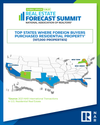FROM THE DESK OF THE CEO: A Legacy of Transformation and Warmest Wishes
I leave HGAR knowing that we are now more member-centric and innovative than ever before.

WASHINGTON—Foreign buyers purchased $54.4 billion worth of U.S. existing homes from April 2020 through March 2021, a 27% decrease from the previous 12-month period and the fourth consecutive annual decline in foreign investment in U.S. residential real estate, according to a new report released by the National Association of Realtors.
Foreign buyers purchased 107,000 properties, down 31% from the prior year, as the COVID-19 pandemic led to a strong global economic contraction and a decline in international tourist and business arrivals. The dollar and sales volumes are the lowest since 2011, when those figures were $66.4 billion and 210,800 properties, respectively.
For the 13th straight year, Florida remained the top destination for foreign buyers, accounting for 21% of all international purchases. California ranked second (16%), followed by Texas (9%) and Arizona (5%), with New Jersey and New York tied at 4%.
NAR’s 2021 Profile of International Transactions in U.S. Residential Real Estate surveyed members about transactions with international clients who purchased and sold U.S. residential property from April 2020 through March 2021. Foreign buyers who resided in the U.S. as recent immigrants or who were holding visas that allowed them to live in the U.S. purchased $32.4 billion worth of U.S. existing homes, a 21% decrease from the prior year and representing 60% of the dollar volume of purchases. Foreign buyers who lived abroad purchased $22 billion worth of existing homes, down 33% from the 12 months prior and accounting for 40% of the dollar volume. International buyers accounted for 2.8% of the $5.8 trillion in existing-home sales during that time period.
“The big decline in foreign purchases of homes in the U.S. in the past year is no surprise, given the pandemic-induced lockdowns and international travel restrictions,” said NAR Chief Economist Lawrence Yun. “Yet, even with the absence of foreign buyers, the U.S. housing market strengthened solidly.”
Total U.S. existing-home sales plunged to a seasonally adjusted annual rate of 4.01 million in May 2020. Sales fully recovered by July, eventually reaching a peak of 6.73 million in October.
China and Canada remained first and second in U.S. residential sales dollar volume at $4.5 billion and $4.2 billion, respectively, continuing a trend going back to 2013. India ($3.1 billion), Mexico ($2.9 billion), and the United Kingdom ($2.7 billion) rounded out the top five. The United Kingdom was the only country among the top five to see an increase in dollar volume from the previous year ($1.4 billion to $2.7 billion) and it replaced Colombia as the fifth largest country of origin by dollar volume of foreign buyers. The annual dollar volume dropped by at least 50% for foreign buyers from China ($4.5 billion from $11.5 billion), Canada ($4.2 billion from $9.5 billion) and Mexico ($2.9 billion from $5.8 billion).
“As travel restrictions loosen and foreign students return to U.S. colleges in the upcoming year, there is likely to be some growth in foreign buying of U.S. real estate,” Yun added. “High home prices and the ongoing lack of inventory could, however, pose a challenge for buyers.”
The median existing-home sales price among international buyers was $351,800, 15% more than the $305,500 median price for all existing homes sold in the U.S. The price difference primarily reflects the locations and type of properties desired by foreign buyers. At $476,500, Chinese buyers had the highest median purchase price, and more than a third—34%—purchased property in California.
All-cash sales accounted for almost two out of five—39%—international buyer transactions, with a higher percentage among non-resident compared to resident foreign buyers at 61% and 24%, respectively. More than four out of five buyers from the United Kingdom—82%—made all-cash purchases, the highest share among foreign buyers. Asian Indian buyers were the least likely to pay all-cash at just 8%. Two-thirds of Canadian buyers (66%), two out of five of Chinese buyers (40%), and a third of Mexican buyers (33%) made an all-cash purchase.
Forty-three percent of foreign buyers purchased the property for primary residence use and 65% purchased detached single-family homes and townhouses. Nearly half of international buyers—49%—purchased a home in the suburbs and 28% bought a home in an urban area, a figure that’s held steady over the last six years. Seven percent of foreign buyers bought property in a resort area, down from 17% in 2012.
“Driving economic development through our work to foster diverse and inclusive communities remains a top priority for NAR,” said Katie Johnson, NAR’s general counsel and chief member experience officer. “Our association collaborates with groups across the country to educate foreign buyers on the opportunities in U.S. real estate and to maximize the global business potential in our local markets. NAR and the Realtor brand has grown to a network of more than 100 real estate associations across 85 countries, ensuring stable, accessible markets that allow our members to make direct connections with global real estate professionals and sources of foreign investment.”
Receive original business news about real estate and the REALTORS® who serve the lower Hudson Valley, delivered straight to your inbox. No credit card required.